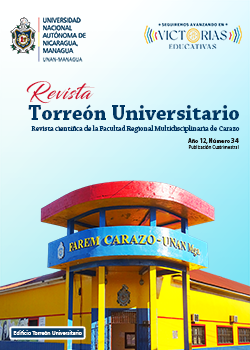Multifunctional furniture design for low-income housing in Autlan, Jalisco, Mexico
DOI:
https://doi.org/10.5377/rtu.v12i34.16356Keywords:
Accessibility, Multifunctional furniture, Lowincome housing, Ergonomics, AnthropometryAbstract
Due to their dimensions and design, low-income housing presents deficiencies in space optimization; and by integrating common furniture, it does not adapt adequately to the areas assigned for its use. The objective of the study was to optimize the furniture for social housing in Autlan, Jalisco, Mexico. The research method was descriptive, correlational, purposeful and field. Three representative colonies from Autlan (Infonavit, Villas Taurinas and Valle del Vergel) were taken for sampling. These colonies are characterized by having small living spaces. A total of 150 questionnaires were made with answers by category and multiple choice, in addition, variables of the questionnaire
used were analyzed and the most demanded modular design proposal for multifunctional furniture was elaborated, based on the preference of inhabitants of living spaces. With regard to reasons for preference of furniture by inhabitants of the study area, the aspect that they referred to with greater relevance was; comfort followed by spatial function. Concerning the reason for the placement of furniture by those interviewed, the first factor was the adequacy of space, followed by the factor of comfort, storage and finally functionality. This research contributed to the economic-social factor of the population studied.
Downloads
References
Alahudin, M., Nurhusna, A., & Simorangkir, Y. V. (2018, December). e Effect of Using Innovative Furniture on
Space Circulation in Lease Houses in Merauke. In International Conference on Science and Technology (ICST
(pp. 968-971). Atlantis Press.
Ahn, Y. (2017). NEST: e development of functional furniture as product convergence.
Bei, F., & Jing, Y. (2013). e Creative Design Research of Personalized Furniture. In Proceedings of 2012
rd International Asia Conference on Industrial Engineering and Management Innovation (IEMI2012) (pp.
-192). Springer Berlin Heidelberg.
Briseño Saénz, J. E. (2009). Estudio para el mejoramiento del mobiliario en casas de interés social de la ciudad de San
Luis Potosí, SLP. Una alternativa actual para el vínculo entre el medio rural y urbano.
Cabrera, M. A. G., & Peñate, O. P. (2015). Creación de una plataforma interactiva para la comercialización de
mobiliario modular personalizado en espacios reducidos. Revista Arte & Diseño, 13(2).
Calderón Tenorio, V. E., & López Espinoza, Z. E. Línea de diseño para la creación de muebles multifuncionales.
Proyecto de emprendedurismo.
Chen, D. (2016). Fika Living: A sharing multifunctional furniture for single person households.
Coleman, R., Keates, S., & Lebbon, C. (2003). Inclusive design: Design for the whole population.
Correa Montes, M. A. (2010). Mobiliario multifuncional compacto para nuevas viviendas colombianas.
Cuaderno Estadístico Municipal IEEG. (2019). https://iieg.gob.mx/contenido/Municipios/Autlan19.pdf
Cubilla, A., & Yaciel, S. (2020). Nivel de conocimiento de la accesibilidad arquitectónica y urbanística para las personas
con discapacidad en el corregimiento de Santiago, 2020.
Eckelman, C. A. (2003). Textbook of product engineering and strength design of furniture. Purdue University, West
Lafayette, Indiana, 65-67.
García, M., & Ruiz, D. (2012). El cuerpo y los gestos en la escuela. Talleres, 13, 45-48.
HÁBITAT, O. Los Objetivos de Desarrollo Sostenible y la Iniciativa de Ciudades Prósperas.» ONU HÁBITAT.
León Moscoso, V. (2019). Habitar y trabajar en un mismo espacio usando un mobiliario multifuncional (Bachelor's
thesis).
Nasser, F. (2013). Multifunctional furniture for underprivileged communities: A milestone in sustainable development
(Doctoral dissertation, Purdue University).
Rajan, A. P., Elavarasan, D., Balaji, S., Dinesh, A., & Gowtham, K. (2019). Design and fabrication of multifunctional
furniture. Int. J. Res. Eng. Sci. Manag, 2, 442-447.
Rodríguez Sánchez, S. A., y Gómez Janer, D. A. (2018). Plan de negocios enfocado a venta mobiliario multifuncional
para áreas residenciales reducida.
Tenorio Tupacyupanqui, M. V. (2014). Diseño de mobiliario multifuncional para el programa de viviendas del EMUVI
(Bachelor's thesis, Universidad del Azuay).
Youssef Yusuf, O., & Pardo Martínez, E. DIMO: mobiliario modular para viviendas de interés social prioritario.
Wang, S. (2013). An analysis of transformable space saving furniture.
Figuras 1, 2 y 3: Adaptado de Google Earth, 2020 (https://earth.google.com/web/search/Autl%c3%a1n+de+Navarr
o,+Jal./@19.76808732,104.36536513,926.22429381a,17489.68890738d,35y,0.00155802h,0t,0r/
data=CoIBGlgSUgolMHg4NDI0NTVjZTNkMWI3MzRkOjB4MzRiNDYyNTExNTBjNjIxZhk7F0Z6UcUzQCFjI7X1eBdawCoXQXV0bMOhbiBkZSBOYXZhcnJvLCBKYWwYAiABIiYJVcwVhZawCEV8j4-IBhawA)
Figuras 4 a 10: Autores, 2020.
Published
How to Cite
Issue
Section
License
Copyright (c) 2023 National Autonomous University of Nicaragua, Managua

This work is licensed under a Creative Commons Attribution-NonCommercial-NoDerivatives 4.0 International License.
The authors who publish in this journal agree to the following terms.
- The author or authors of the articles, essays or research grant the National Autonomous University of Nicaragua, Managua (UNAN-Managua) the editing rights (copyright) of the submitted work, therefore the University has the exclusive right to publish the article for the entire copyright period.
- These copyrights/authors authorize Torreón Universitario Magazine and the University to edit and disseminate/publish the article in said Magazine, including printed and electronic reproduction, storage, retrieval and any other type of publication, and sources of secondary information as services. of summaries and databases, they also empower it to protect the article against unauthorized use for dissemination by printed or electronic media (PDF, HTML, EPUB, XML or others).
License for use of content
The magazine uses the Creative Commons Attribution-NonCommercial-NoDerivs 4.0 International License.
Under this statement:

This journal is licensed under a Creative Commons Attribution-NonCommercial-NoDerivatives 4.0 International License. It can be copied, distributed and transmitted publicly as long as the author and source are cited (Revista Torreón Universitario), it should not be modified or used for any commercial purpose. The full license can be found at http://creativecommons.org/licenses/by-nc-nd/4.0/.



